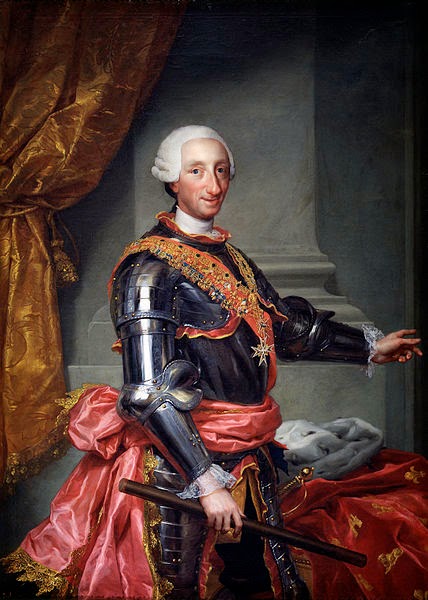(image from the web)
The European holdings of Carlos I of Spain (Charles V of the Holy Roman Empire)
During the reign of Carlos, Spain's empire in the New World increased dramatically. In 1521, Hernan Cortés conquered the Aztec empire in Mexico, and in 1532 Francisco Pizarro conquered the Inca Empire in South America. Vast riches of gold and silver from the Americas poured into Spain. Spain was the superpower of the era.
Unfortunately, Carlos did not use this vast wealth to develop the economy of Spain. Rather he squandered it in continual wars with France, the Ottoman Empire and in Italy. Plagued by poor health (epilepsy and severe gout) and burdened with the responsibilities of ruling two empires, Carlos abdicated in 1556, leaving the Holy Roman Empire to his brother, and the Spanish Empire, the Low Countries and the Italian possessions to his son Felipe.
Felipe II of Spain
King Felipe II was a well educated and hard working monarch. He could have been a great monarch, but, like his father, he wasted his nation's wealth on wars... most of them of a religious motivation. The devout Felipe was determined to defend Catholicism against the rise of Protestantism and the Moslem threat of the Ottoman Empire. He was involved in a prolonged war with the Dutch Protestants in the Netherlands who were fighting for independence. In league with several other states, he led a naval expedition against the Ottoman Turks and won a victory at the Battle of Lepanto.
One of his greatest obsessions was with England. During his father's reign, King Henry VIII had broken away from the Catholic Church in order to divorce his wife, Catherine of Aragón (Felipe's aunt). When Catherine and Henry's daughter Mary (known in history as "Bloody Mary") came to the throne, she reinstated the Catholic faith in England. Felipe married his cousin Mary, and they hoped that their children would secure England's Catholic future. However, Mary died childless, and was succeeded by her Protestant sister Elizabeth. Felipe considered Elizabeth the bastard daughter of an illegitimate marriage, and planned to bring England back to the Catholic fold by force. He built a fleet of 130 ships, known as the Spanish Armada, and in 1588 planned to invade England. The campaign was a disaster. The heavy Spanish fleet was defeated by the lighter, more maneuverable English vessels, and then the armada was further damaged by storms at sea. Only one third of the mighty fleet made it back to Spain.
During Felipe's reign, Spain had reached the peak of its power, but his wars bankrupted the Spanish treasury, and Spain's economy was deteriorating.
Felipe died in 1598, and was succeeded by his son Felipe III. The Habsburg dynasty continued to rule Spain throughout the 1600s. Felipe III and his son Felipe IV were much less competent, and the country's economy and political power continued to decline. Nevertheless, Spain continued to have the largest colonial empire of any country in Europe.
The country's "Golden Age" included some of the finest literary and artistic production of its history. Spain's greatest writer, a contemporary of Shakespeare, was Miguel de Cervantes. His masterpiece, Don Quixote, is considered the first modern European novel, and one of the world's greatest works of literature. The novel, about an addled Spanish gentleman, who dreams of being a knight in shining armor, began as a satire on books of chivalry, but developed into a portrait of human nature, and an analysis of idealism versus realism. Another great writer of the era was Cervantes' rival, Lope de Vega. This playwright was the most prolific writer in all of world literature. He wrote more than 1800 plays, all in verse.
In the field of art, the two most famous names are El Greco and Velázquez. El Greco (his real name was Domenikos Theotokopulos) was born in Greece, but spent most of his life in Toledo, Spain, where he painted religious works in a distinctive mystical style.
El Greco's masterpiece, "The Burial of the Count of Orgaz"
Diego Velázquez was the court painter of Felipe IV. His many portraits include not just pictures of the royal family, but also the jesters and "fools" of the court, and the Spanish peasantry. Many a Spaniard would tell you, "Forget the Mona Lisa... the greatest canvas ever painted was his masterpiece Las Meninas!"
,_by_Velazquez.jpg)
"Las Meninas" (The Maids of Honor) captures a moment in the life of the royal family. Imagine that you are looking at this through the eyes of the King or Queen of Spain. (See your reflection in the mirror on the back wall?) You are posing for a portrait. There is Velázquez with brush and palette in hand. Your little daughter, the lovely Princess Margarita, has stopped by to visit you. She is, of course, escorted by her retinue, her maids of honor, her tutors, and even one of the dwarves who were kept for the amusement of the court. Whether or not this is the greatest painting of all time is a matter of debate. It is certainly one of the great works of 17th century art, and today holds a place of honor in the Prado Museum of Madrid.
The Habsburgs come to an unfortunate end with Carlos II. Generations of inbreeding among the Habsburgs came to a culmination in Carlos, who suffered such physical and mental disabilities that he was known as Carlos "el Hechizado" (the Bewitched).
Carlos II of Spain
Carlos died in 1700 leaving no heirs. (He was most likely impotent.) His closest surviving relative was a great-nephew, Philippe, the Duke of Anjou and grandson of Louis XIV of France. So, with the dawning of the 18th century, Spain was to ruled by a new dynasty, the Bourbons of France.
|





























,_by_Velazquez.jpg)




















